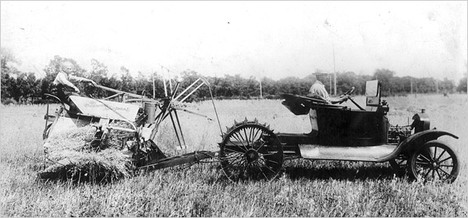 “OFF ROAD; Kits to take the Model T places Henry Ford never intended included tractor conversions, . . . ” Source of caption and photo: online version of the NYT article quoted and cited below.
“OFF ROAD; Kits to take the Model T places Henry Ford never intended included tractor conversions, . . . ” Source of caption and photo: online version of the NYT article quoted and cited below.
(p. 1) WHEN Henry Ford started to manufacture his groundbreaking Model T on Sept. 27, 1908, he probably never imagined that the spindly little car would remain in production for 19 years. Nor could Ford have foreseen that his company would eventually build more than 15 million Tin Lizzies, making him a billionaire while putting the world on wheels.
But nearly as significant as the Model T’s ubiquity was its knack for performing tasks far beyond basic transportation. As quickly as customers left the dealers’ lot, they began transforming their Ts to suit their specialized needs, assisted by scores of new companies that sprang up to cater exclusively to the world’s most popular car.
Following the Model T’s skyrocketing success came mail-order catalogs and magazine advertisements filled with parts and kits to turn the humble Fords into farm tractors, mobile sawmills, snowmobiles, racy roadsters and even semi-trucks. Indeed, historians credit the Model T — which Ford first advertised as The Universal Car — with launching today’s multibillion-dollar automotive aftermarket industry.
For the full story, see:
LINDSAY BROOKE. “Mr. Ford’s T: Mobility With Versatility.” The New York Times, Automobiles Section (Sun., July 20, 2008): 1 & 14.
(Note: the online version of the story has the title “Mr. Ford’s T: Versatile Mobility.”)
